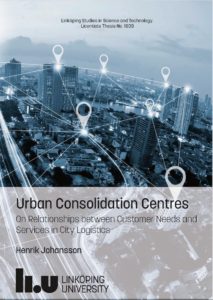Urban Consolidation Centres (UCCs) are often conceived as an enabler to alleviate negative effects associated with distribution of goods in cities, such as traffic congestion and hazardous emissions. UCCs not only have the potential to reduce these effects but also provide alternative distribution solutions by introducing new transhipment points.
A new thesis by Henrik Johansson, Linkoping University (Sweden), on Urban Consolidation Centres provides new insights on the relationships between customer needs and services in city logistics.
Not self-supporting
Despite their potential, UCCs often fail to be self-supporting and are often dependent on subsides, which is not considered to be sustainable in the long run. In response, this thesis takes its point of departure in the two business models elements value propositions and target customers. A business model is often viewed as an enabler to generate revenue and UCCs have the potential to generate revenue by offering services to their customers, and the customers pay for the services.
Customer needs
To understand how customers can benefit from UCCs and provide arguments why they should use UCCs, it is important to understand the relationship between customers’ needs and the services UCCs can provide. The purpose of this thesis is to identify and describe the potential relationship between needs of UCC customers and UCC services.
The research in the thesis is both explorative and descriptive, where a first step is to identify customer needs, UCC services, and value propositions. The descriptive part is to describe them and it is also the foundation for understanding the relationship between customer needs and UCC services. Through the analysis and discussion, multiple customer needs are identified and described for seven customer groups and the UCC operator; all of which could be considered customers of UCCs.
New UCC services
The thesis also adds to the UCC literature with three new identified UCC services: e-commerce with used products, advertisement, and registration in computer system. The outcome of the analysis also provides illustrations of how customer needs can be matched with UCC services. For the most studied customer group, receiver of goods, a total of 29 different matches were identified, which illustrates the possibilities but also the complexity of the relationships. To understand the relationship, three different types of gaps were also identified that have implications for future research.
The main contributions to research and the UCC literature in particular are enlargement of the scope of customers and the illustration of the relationships between customer needs and UCC services. The illustrations include contributions such as identifying, mapping and describing the customer needs, UCC services, and value propositions.
An important first step is to understand how customer needs and UCC services can be linked, and this thesis provides examples of how this can be achieved. Viewing every stakeholder as a potential customer opens up the opportunity to fulfil their needs and the potential to generate revenue, which in turn could close the gap in the problem of non-self-supporting UCCs. With self-supporting UCCs, the number of freight vehicles can be reduced and this may lead to more attractive cities with less traffic congestion and lower emissions.
For more information, click here.

